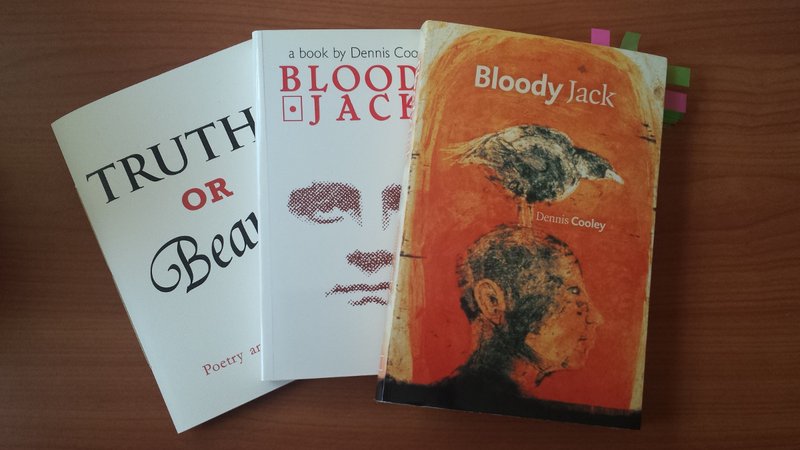Truth or Beauty and Bloody Jack

- Benjamin Laird
At the end of November I presented a paper at Truth or Beauty: Poetry and Biography in Wellington. It was useful and interesting to hear a range of views on biographical poetry (or verse biography as it was sometimes referred).
I presented on my own works-in-progress but mostly on Dennis Cooley’s Bloody Jack. Bloody Jack, which is loosely about the life of the early twentieth-century Manitoban outlaw John Krafchenko, has two editions. The first was published in 1984 with the second edition—which includes alterations to poems, additional poems and poems moved within the sequence—published in 2002. What is fascinating about the two editions of Bloody Jack is how the representation of John Krafchenko’s life story in them is unstable.
Biographical poetry tends not to get its own description so my starting point was within documentary poetry (which is too wide a category but I will leave that to another day/post). Particularly, Canadian documentary poetry that was first suggested by Dorothy Livesay and then revisited by Stephen Scobie. Stephen Scobie writes that the Canadian documentary poem
is a long poem, or sequence of poems, usually book length, and narrative in structure. The events which make up this narrative are documented, historical happenings, although the poet will frequently modify or shuffle these events, or add purely fictional incidents. The poem often focuses on a single character who took part in these events, and this character’s biography (up to and sometimes beyond his or her death) provides the structure of the book. Many of the poems adopt the persona or speaking voice of this central character.
I think what Scobie recognised in Canadian poetry in 1984 (the same year that Bloody Jack was published) was the growth and development of biographical poetry. He traces the change in documentary poetry to Michael Ondaatje’s The Collected Works of Billy the Kid and Margaret Atwood’s The Journals of Susanna Moodie. This definition, however, suits Australian biographical poetry making this applicable to works beyond Canada. It fits Australian biographical works from James McAuley’s Captain Quiros (1964) to Jessica Wilkinson’s Suite for Percy Grainger (2014).
Unpicking Scobie’s description a little more, he posits that the poetry is both “narrative in structure” and that the “character’s biography (up to and sometimes beyond his or her death) provides the structure of the book”. For books that do not need to be read in a linear fashion (or for works in programmable media) the character’s life providing “the structure of the books” becomes an intriguing proposition.
Dennis Cooley, in both editions of Bloody Jack, is playful with form—many poems are experimentally laid out—and structure—the differing order of poems between editions, which also do not require being read sequentially.
So with a work like Bloody Jack that encourages a multiplicity of readings and do not necessarily have a fixed authoritative order because of that (though as Bloody Jack is bound as a book an order is implicitly suggested) they upset notions of any fixed authoritative life stories. While, in print, most biographical poetry works are not like Bloody Jack, in that they seem to suggest a more singular narrative reading, Bloody Jack can suggest a multiplicity of readings because it is poetry. As such, all biographical poetry has this to some degree.
Even though the works are resistant to traditional descriptions of narrative, I situated the discussion within the relationship between narrative and poetry (or narrative in poetry). I found McHale’s essay an excellent starting point (as did other presenters). His use of Rachel Blau DuPlessis’s proposal, from Manifests, that “segmentivity—the ability to articulate and make meaning by selecting, deploying, and combining segments—is the underlying characteristic of poetry as a genre” is a good way of describing how Bloody Jack functions but it also gave me an important way of thinking about biographical poetry in programmable media.
Furthermore, segmentivity is not mutually exclusive from the two other qualities that DuPlessis identifies: narrativity, the “central aspect of storytelling—making sequenced events with some point unroll in represented time” and performativity, the “means making elements of coded and decodable gestures in special space and time”. There are some amounts of segmentivity, narrativity and performativity in biographical poetry in programmable media, which vary on a poem-by-poem basis.
Moreover, segmentivity in poetry in programmable media has spatial and temporal dimensions. This is more-or-less the conclusion that my paper arrived at but given poetry’s ability to subvert narrative I keep wondering how to balance fragmentary and linear elements. The threats from either side is that if the poem is too narrative you may end up with chopped up prose while if the poem is too fragmentary it risks the possibility that biographically representation is lost. Fundamentally, the question is how to maintain the biographical work while balancing segmentivity, narrativity and performativity.